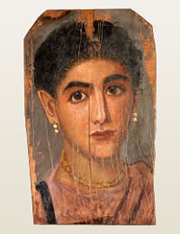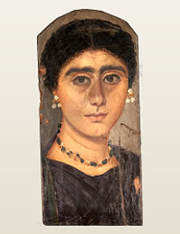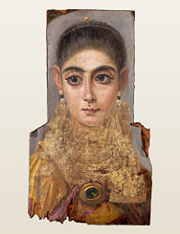|
 |
Louvre-DNP Museum Lab Customer Center
Tel: +81 (0) 35435 0880, Monday to Friday, 9 a.m. to 6 p.m. Closed on Saturday,Sundays and public holidays. |
|
 |
|
 |
 |
These paintings were found all along the Nile, but are commonly known as "Fayum portraits" as they were first discovered in large numbers in the Fayum region of Egypt, in the last quarter of the 19th century.
They were painted on wooden panels from live models, and reused on the person's mummy after his or her death, replacing the Egyptian mummy masks that had symbolized the rebirth of the deceased in the afterlife. They were first used in this way in the reign of Tiberius (AD 14–37), in the early Christian era when Egypt was already under Roman rule.
These extraordinary works of art, preserved by the dry climate, are the only surviving examples of portrait painting in the ancient world, and show us the multiple faces of a whole society. |
|
 |
 |
 |
 |
Portrait of a woman
Second half of the 2nd century AD.
Limewood (Tilia sp., Tiliaceae), encaustic
H. 31 cm; W. at the bottom 18.8 cm; W. at the top 20 cm; D. 0.1-0.2 cm
Provenance: unknown, perhaps Thebes
Paris, Musée du Louvre, N 2733.3
© 2007 Musée du Louvre / Georges Poncet |
|
 |
This portrait, one of the first to enter the Louvre's collection, belonged to Henry Salt, the British consul in Cairo, who sold part of his collection to the Louvre in 1826. It was on public display throughout the 19th century in the rooms devoted to Egyptian antiquities.
The original panel of very thin limewood was glued to a modern wooden board, probably before the portrait entered the museum.
The painting shows a young woman, turned a little to the left. She has a long, oval face with a slightly prominent chin. The volume of the nose is indicated by a lighter line down the bridge and the large shaded area on the left. The eyes, which are not quite aligned, are outlined with touches of brown ocher; the irises are hazel, and each black pupil is marked with a white dot.
The woman is wearing hoop earrings with two white pearls, and a necklace with large gold links painted in yellow ocher and outlined in red orcher. Her tunic and cloak are both the same shade of pink. The right shoulder of the tunic is adorned with a narrow black stripe (or clavus). The folds and contours of the cloak are indicated by long purple brushstrokes that begin at the left shoulder and cross the breast. The woman's hairstyle―parted in the center, arranged in parallel waves and tucked behind the ears—reflects the fashion of the latter half of the 2nd century AD. |
 |
|
|
 |
 |
 |
 |
Portrait of a woman
Middle of the 2nd century AD.
Sycamor fig wood (Ficus sycomorus L., Moraceae), encaustic
H. 37 cm; W. 17 cm; D. 1 cm
Provenance: Antinoopolis
Paris, Musée du Louvre, E 12569
© 2007 Musée du Louvre / Georges Poncet |
|
 |
The portrait was found by the archaeologist Albert Gayet during the excavation campaign of 1904 or 1905 at the necropolis of Antinoopolis in Middle Egypt. It entered the Louvre's collections in 1905.
A fragment of the right side of the board has been reglued. The paint has worn away on the nose, leaving a dark mark where the brown undercoat shows through.
This is an almost full face portrait of a young woman turned slightly to the right, but looking directly at the viewer. Her well defined mouth is accentuated by a shadow under the lower lip; a touch of pink indicates a dimple on her chin. Her hair is parted in the middle, and arranged in parallel waves painted in thick strokes of black.
The woman is wearing a dark purple tunic with a cloak of the same color over her left shoulder. The tunic is adorned with a dark green stripe (or clavus) that starts at her right shoulder.
Her earrings reflect the fashion of the 1st and 2nd centuries AD: a pearl, a horizontal gold bar, and two pendants each ending in a pearl. The necklace is composed of long dark green beads interspersed with gold rosettes. The hairstyle could be dated to Hadrian's reign (117–138 AD) were it not for the fact that the ears are hidden, which suggests a slightly later date. |
 |
|
 |
 |
 |
 |
Portrait of a woman known as "L'Européenne" |
 |
 |
|
 |
 |
 |
 |
Portrait of a woman known as "L'Européenne"
First half of the 2nd century AD.
Cedar wood (Cedrus sp., Pinaceae), encaustic, partially gilded
H. 42.5 cm; W. at the bottom 24 cm; W. at the top 17.4 cm; D. 1.2–1.6 cm
Provenance: probably Antinoopolis
Musée du Louvre, MND 2047
© 2008 Musée du Louvre / Georges Poncet |
|
 |
This portrait was purchased in 1951 from antiques dealer Roger Khawam, and was the last to enter the Louvre's collection. The shape of the board—narrow at the head, wider at the shoulders—and the stylistic resemblance to a portrait in the Musée des Beaux-Arts de Dijon (found by archaeologist Albert Gayet) suggest that it came from the city of Antinoopolis. On her arrival at the museum, the young woman in the portrait was dubbed "L'Européenne (the European)"—for no other reason than her pale complexion. The painting soon came to symbolize the museum's portrait collection for its exceptional artistic quality and the charm of the subject, with her slightly lowered gaze.
The young woman's face, with its pearly complexion, is characterized by large eyes that look rightward rather than at the viewer—which is rare in such portraits. Her hair is drawn back from her face, showing her ears, and a braid at the crown of her head is fastened with a hairpin whose gold tip is carefully painted. Her jewelry consists of a large oval brooch at her breast, pearl earrings… and a pearl necklace, hidden by the gold leaf that covers her neck and upper bust. Though gilding was often added for funerary purposes, its application to the neck is unique to this portrait. |
 |
|
|

